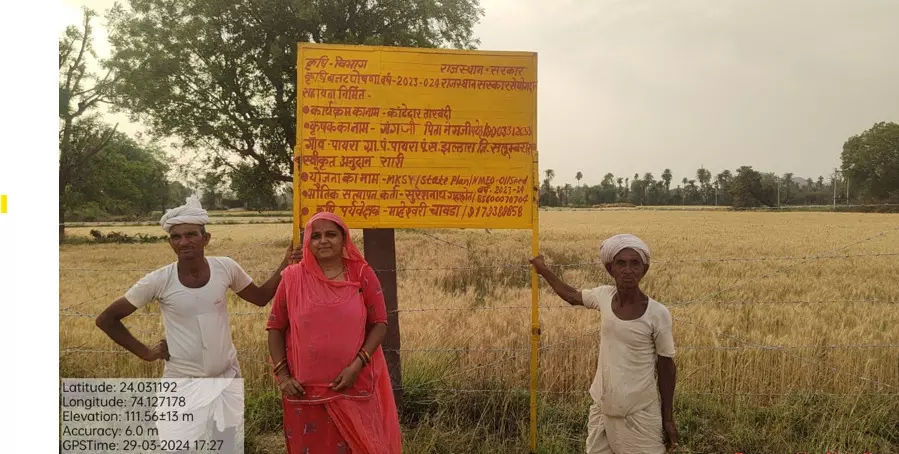Nexus of Good: Boosting incomes
Under Jasmeet Singh's leadership, Salumbar district has managed to implement multiple integrated agricultural schemes, eventually leading to enhancement of farmers’ income

The objective was not only noble but also eminently desirable. The Prime Minister had provided the vision of doubling farmers' income. It was now the responsibility of those in the field to bring this vision to fruition. While most districts in the country struggled, a remarkable initiative was undertaken in the remote district of Salumbar in Rajasthan. Under the inspired leadership of the Collector, Jasmeet Singh, benefits from the National Mission on Micro Irrigation, Per Drop More Crop, Rashtriya Krishi Vikas Yojana (RKVY), the National Horticulture Mission, and PM KUSUM were combined to boost farmers' incomes. A primary goal was to make farmers independent and self-reliant in their agricultural produce. The stated objective of the initiative was to enable farmers to leverage government benefits from all schemes to increase their incomes.
A clearcut strategy was worked out. The farmers and their families were involved in the district after engaging with the community. In each of these programmes, farmers who were pro-technology were identified and sustained focus was placed on them to use all these yojanas to increase agricultural output. All these were put up before Gram Sabha, and after approval, were finalised. Other stakeholders were also consulted. Agriculture department and horticulture department were engaged to guide on technical aspects of the programme. NGOs working in the field of agriculture were also taken on board. Elected representatives were involved in site selection and using local methodology to resolve issues. As part of this programme, all farmers were provided training in Kisan Vikas Kendras. Assistance of farmer groups like Kisan Sangh was taken. Thus, all stakeholders converged to ensure benefits under all government schemes.
Farming is inherently risky due to high input costs, low returns, market linkage issues, and climate uncertainty. To address these challenges, a convergent approach was adopted. Farmers were made independent in terms of water sourcing through farm ponds, ensuring reliable irrigation, and electricity via solar pumps. Benefits from the National Mission on Micro Irrigation, Per Drop More Crop, Rashtriya Krishi Vikas Yojana, the National Horticulture Mission, and PM KUSUM were combined to increase farmers' incomes. Farmers received farm implements under RKVY, farm ponds and plastic mulching were done under the National Horticulture Mission, and high-quality horticultural crop seeds, drip and sprinkler irrigation systems, and solar pumps were provided under PM KUSUM.
One of the key strategies of the initiative was its participative and collaborative approach. As mentioned earlier, this was done by talking to farmer groups and identifying such farmers as were pro technology. The entire exercise was undertaken in a transparent and accountable manner. One of the key strategies centred around selecting crops like cucumber and tomato that were local crops suited for the area. This ensured crop effectiveness. Another key strategy was replicability, as all these schemes such as NHM, RKVY, PMKUSUM, and NMMI were being implemented by the government everywhere. The focus was on scalability of the initiative to ensure that the farmers got higher incomes and were able to practice more scientific farming to reduce water and electricity issues.
The agriculture and horticulture departments served as the nodal agencies, making farmers the most important stakeholders. Through collaborative exercise, farmers were motivated around the concept of more crop per drop and doubling income. District officers were made in charge of a few panchayats and hence they were given routine tasks of going to these panchayats and motivating farmers. NGOs were involved by asking them to mobilise the farmers. The best amongst these were encouraged and awarded at district level for their work. Media was also involved and massive IEC campaigns were organised in the area. Apart from this, visits of experts in the field of agriculture were organised. Thus the whole exercise was done in a participative and collaborative manner.
A key differentiator of the initiative was its sustainability. It was essential to design the initiative to be self-sustaining by adopting local and environmentally friendly solutions. Farm ponds and water harvesting structures provided year-round water availability for farming. Another differentiator was the transparent process, with farmers selected through stakeholder consultations. MGNREGA was dovetailed to ensure local employment and accountability. The techniques employed—such as farm implements, drip and sprinkler systems, mulching, and solar pumps—were easy to implement across Rajasthan's terrain, making the model replicable. The initiative also focussed on grass root awareness of the issues in order to generate sustainable solution.
The initiative in the district has already yielded encouraging outcomes. As part of this effort, the district administration reached over 60,000 farmer families. A total of 1,237 new applications were sanctioned, 271 applications for farm implements were processed under various schemes, and an additional 113 applications for farm ponds and 379 for farm pipelines were approved. Furthermore, 68 new solar pumps were sanctioned under PM KUSUM.
This integrated mode of convergence has helped farmers to increase their incomes as they have not only constructed farm ponds to save water and use it, but are also using solar pumps to reduce electricity use as well as to pump water. This has been further supplemented by use of drip and plastic mulching to reduce water losses and ensure more crop per drop. Good quality horticultural crops are being grown in protected cultivation, leading to continuous increase in income levels of farmers and increasing the number of crops being produced in a year. As farmers are able to generate good quality horticultural crops, this has led to higher incomes. This has ensured higher focus on high quality inputs and hence has facilitated a virtuous cycle. Such an initiative has allowed a sustained focus on doubling farmers’ incomes.
What Jasmeet and his committed team have achieved in the district is a wonderful example of Nexus of Good. The model can be replicated in other parts of the country.
Views expressed are personal



